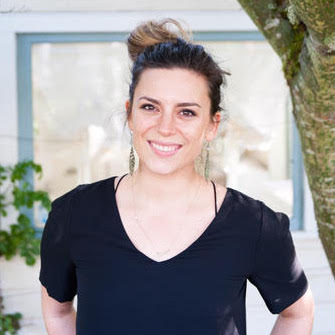This month on the blog, we’re exploring how our particular stories of harm and healing inform our work in the world—meaning vocation and service look different for everyone (and this is a good thing). Here, Jenny Wade (MA in Counseling Psychology, ‘13) reflects on experiences of emotional and sexual repression, her journey of learning to inhabit her body in a new, life-giving way, and how that story helps shape her work with others.
I breathed myself to life, and so can you. My own recovery from the trauma of sexual repression drew me towards the healing medicine of yoga. I am a psychotherapist and a yoga teacher. My passion, obsession, and saving grace is embodiment—the experience of inhabiting the home of your body. Social forces and generational/personal trauma split the psyche into compartmentalization and dissociation, which inhibit us from fully inhabiting our own skin. I came into this work by following the golden thread of aliveness that vibrated inside of me whenever I stepped towards an act of embodiment.
My journey towards my profession and passion began by confronting my own pain of living in a deadened body.
“My journey towards my profession and passion began by confronting my own pain of living in a deadened body.”
As a girl I was steeped in an evangelical church that was emotionally and sexually repressed. I was taught to dissociate from my emotion and sexuality. Eager to perform for my community, I was one of the ‘good’ ones. My dissociative abilities grew stronger as they were reinforced and praised. I swallowed my emotions and wore my pledge of virginity until marriage like a badge of honor. I committed to these ideas with resolve, to the point of receiving a purity tattoo—a dove on my hip that I wouldn’t allow anyone to see until my wedding night.
As a child I was tirelessly praised for my goodness, my ability to follow all of the rules set before me. The only price I had to pay for this endless stream of praise was my unwavering compliance with the group norms of emotional and sexual repression. As long as I agreed that the impulses of my body were wrong and should be ignored at all costs, I was given power, respect, and trust from a group of people I deeply respected.
As a 3 on the Enneagram, “the performer,” my disposition lends me towards being preoccupied with how others see me. ‘Good’ became my identity, and my value was centered around how well I could perform to the expectations of those in authority around me. My obsession with blamelessness made me feel afraid to consider my own right to connection and desire.
It is painful to realize I was brainwashed out of connecting to my own sensuality. Over and over again I kissed my college boyfriend (who is now my incredible, gracious husband) while willing myself outside of my body and interrupting our connection if we got ‘too close.’ For years. For five years. That is too many years of not surrendering to the wisdom of our bodies. Our super power, being deeply present with each other, was shadowed by shame and secrecy. By the time we decided we had waited long enough to have sex, I had retreated so far from the felt experience of my body that I didn’t know how to enjoy it.
Dissociation is the psychological process of blocking out what an individual considers to be harmful. What is defined as ‘harmful’ within an individual is often the parts of self that may inhibit a sense of belonging to a particular community. I was taught that my body was bad and not to be trusted, so I spent the vast majority of my life ignoring what it was saying to me out of an ethical duty to be ‘good.’ I’m not the only one. The bodies of countless people growing up within Evangelical communities have been affected by the shameful rhetoric of purity culture.
The trauma of neglecting and shaming my body during vital years of sexual development caused a severe split between my mind and my body. We don’t learn how to be in our bodies unless we are taught how to follow sensation. In order to keep my purity pledge, I did everything in my power to sever myself from sensation, and in the process inadvertently sent the message to my brain that connection to my body was not to be trusted. My evil body tempted me into sexual sin—an age-old fable more concerned with power than with sex.
Yoga was the first place I learned how to inhabit my body intimately, in a way that wasn’t overtly sexual. Yoga was a neutral environment I could enter to learn how to de-thaw my body, without having to hold the emotional complexity of sexual shame that would often come up during sex. It has been through my own yoga practice that I’ve learned that there is ancient medicine in using breath and movement in order to bring bodies back to life. What has historically been my biggest weakness is turning into my biggest strength because my pain forced me to look so closely at my body.
“There is ancient medicine in using breath and movement in order to bring bodies back to life.”
While I was still dry humping Ben in church parking lots (#wheatonlyfe) in 2006, I attended a ‘stretching and breathing’ class (yoga, in disguise) that changed my life. My body, which I had spent so much time trying to separate from and control, was now being gently paid attention to. I learned how to use movement as prayer, and for the first time I began to see how being with my body was a worshipful experience. It made my heart burst wide open to pay attention to myself in this way. Each time I laid in savasana, the final resting pose at the end of a yoga class, I came into direct contact with the weirdness and goodness of my body, the pure delight of feeling my own aliveness. These magical experiences in my body drew me to enroll in a yoga teacher training the summer before I started class at The Seattle School. Immersed in the world of body wisdom I began, piece by piece, to land into a body I wasn’t fully aware I had disowned.
After I graduated, I spent four years working at Opal: Food + Body Wisdom, a local eating disorder clinic that was my therapeutic boot camp. Working with clients with eating disorders is a minefield of body hatred and dissociation, and I needed to learn quickly how to help my clients tolerate being in bodies that felt deeply unsafe to inhabit. I voraciously read books on embodiment and somatic healing from trauma, and I realized as I read that I needed to heal myself. The deeper I dove into healing my relationship with my body, the more I could teach my students how to find islands of safety within their own skin.
Dissociation is a form of trauma that leaves the body frozen, numb, and unresponsive. When trauma and neglect happen, we need to vacate. It is a sweet gift that the body doesn’t allow us to come into full contact with the enormity of our pain when we aren’t safe enough to feel it. I see the body as a manifestation of the unconscious mind, and when we work explicitly with the physical body, we grow awareness to the most hidden parts of our psyche. Yoga is a way to slowly reintroduce ourselves to the disowned parts of ourselves. Using the tools of breath and focused awareness, we can gradually thaw the frozen, clenched parts of our bodies. Now in my private practice, I’m teaching my clients and yoga students how to reclaim the uncharted waters of their own bodies using meditation, yoga, and breathing practices.
It wasn’t until I began connecting to my body that I realized how deeply disconnected I had been my entire life. Even now, after spending the last decade working to integrate the experiences of my body, I’m more aware than ever about how much I still don’t know about this earth suit of mine. It is endlessly mysterious and mystical to discover the maps of intelligence that are encoded into our bodies. I’ll never arrive at a perfectly embodied or integrated place, but I have breathed myself into a new body. A more fluid, open, welcoming, and grounded body. A body that knows how to lean into care because of all those times she leaned into the earth in savasana and felt held.


